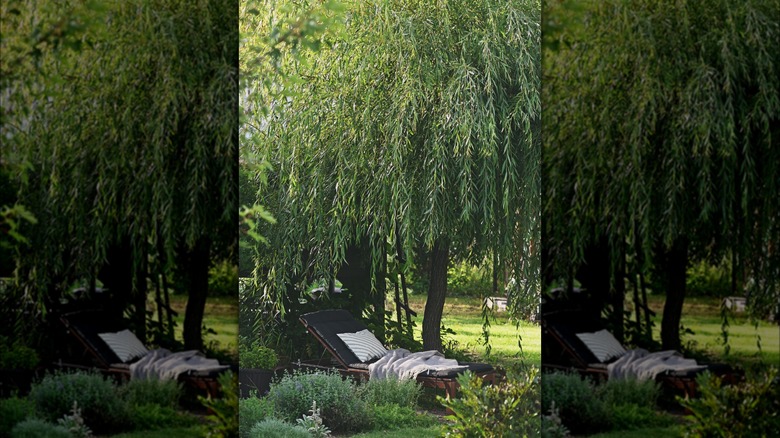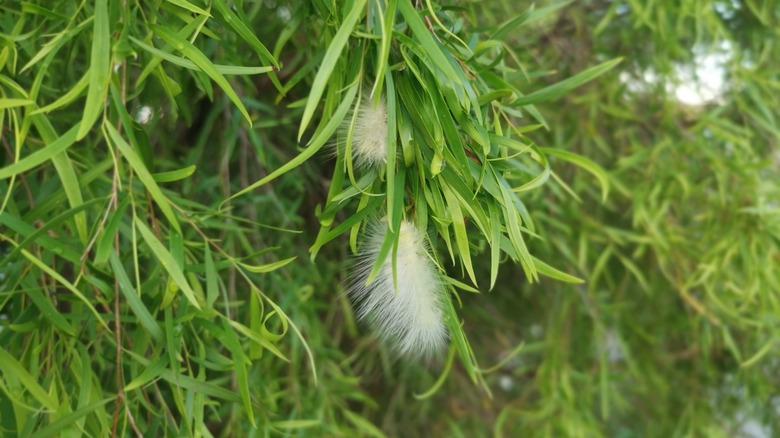This Fast-Growing Tree Is A Beautiful Way To Add Shade To Your Yard
With their ground-sweeping and delicate glaucous leaves, weeping willows (Salix babylonica) have moved hearts galore. In the past, they've acted as Monet's muses (at least 10 times!) to express remorse and hope during World War I and have also stirred philosophical musings in people. But lately, they've been assuming the role of a fast-growing shade tree in sunny backyards. Hardy from USDA zones 6 through 8, these majestic specimens grow between 30 and 40 feet wide and just as tall, making them perfect for growing in large gardens. Armed with beautifully furrowed, ashy gray bark and reddish-brown branches that eventually get taken over by bronzing fall foliage as they mature, they can add character to any space.
Although pitching with the deciduous trees, weeping willows have the best of the lot. They don't shed until the frost has settled in, but they bloom early — sometimes in February — when spring is around the corner. They grow over 1-inch-long, silverish-green catkins (composite flowers) that support specialized bees, viceroy larvae, and butterflies. Additionally, they live about 30 years but may survive for longer if cared for properly. Varieties like Tristis, Aurea, Golden Curls, and Babylon are fairly popular.
What weeping willows need to grow
Weeping willows will turn weepy (aka straggly) if they aren't given sufficient sunlight. Ideally, they need about six hours of exposure but make do with partial shade. Luckily, they aren't too hung up on the soils and can flourish in all types, including clay, sand, and loam. Slight acidity or alkalinity isn't a deal breaker either. However, they rejoice in wet substrates, popularizing them around water features and rain gardens. Several Midwest-based gardeners plant these Salix varieties to restore their muddy lawns from the frequent rainfall. They also perform well on slopes and control erosion. While they can withstand drought stress, routine watering will keep them from dropping leaves unless it's their shedding season. Fertilization isn't necessary except when the soil is deficient.
As weeping willows gain almost 3 to 4 feet annually (or even more during rainy seasons), they work great as screens or fences. Unfortunately, the fast growth comes at the price of weak wood. While training in the initial growth years should help strengthen these trees, they still won't stand much chance against strong gales, forcing you to pick up some broken limbs. But that might not be so bad if you've got a fire pit in your yard.
Caveats to planting weeping willows
Although Salix babylonica isn't technically on the national invasive list, it has been tagged so in Arlington, VA. Weeping willows are dioecious, meaning they grow distinct male and female trees with their set of catkins. While the showy male flowers are stamens-only (thus, not invasive), their female counterparts produce abundant seeds that can germinate wherever the breeze takes them. Even their broken branches can take root, which is terrific for propagation, but it's terrible if you're trying to limit their spread.
Moreover, weeping willows grow shallow roots that can conflict with the lawnmower. Their roots are also voracious spreaders, sometimes extending three times wider than the canopy's width. So, you'll have to ensure they don't encroach on your sewage system or underground utility lines. Also, the trees should be planted at least 50 feet away from the foundation and any major structures. Further, keep an eye out for irksome pests like gypsy moths, aphids, scales, and caterpillars. Consider planting them in the fall to give the roots sufficient time to establish and avoid weeping willow-loving cicada broods. Diseases like bacteria blight, cankers, and powdery mildew are also concerning if the trees are left unpruned, so learn how to trim your weeping willow tree correctly.


